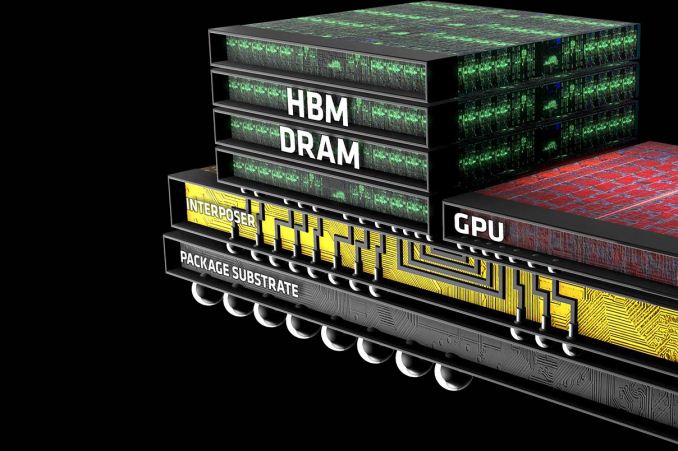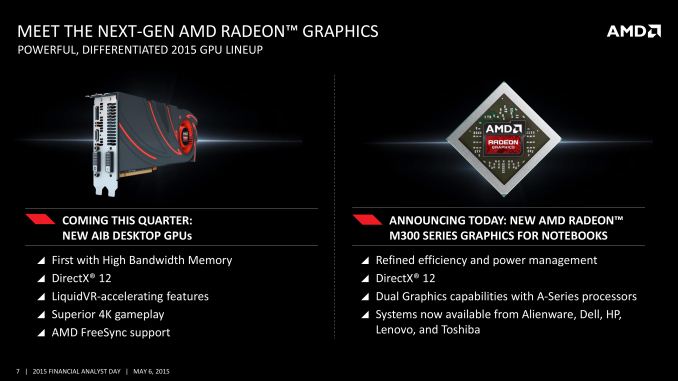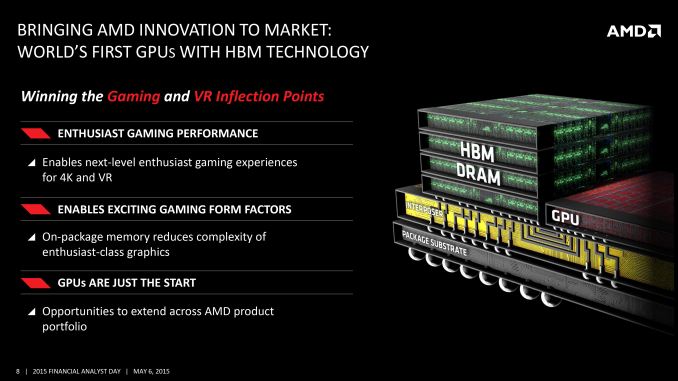AMD Dives Deep On High Bandwidth Memory - What Will HBM Bring AMD?
by Ryan Smith on May 19, 2015 8:40 AM EST
Though it didn’t garner much attention at the time, in 2011 AMD and memory manufacturer Hynix (now SK Hynix) publicly announced plans to work together on the development and deployment of a next generation memory standard: High Bandwidth Memory (HBM). Essentially pitched as the successor to GDDR, HBM would implement some very significant changes in the working of memory in order to further improve memory bandwidth and turn back the dial on memory power consumption.
AMD (and graphics predecessor ATI) for their part have in the last decade been on the cutting edge of adopting new memory technologies in the graphics space, being the first to deploy products based on the last 2 graphics DDR standards, GDDR4, and GDDR5. Consequently, AMD and Hynix’s announcement, though not a big deal at the time, was a logical extension of AMD’s past behavior in continuing to explore new memory technologies for future products. Assuming everything were to go well for the AMD and Hynix coalition – something that was likely, but not necessarily a given – in a few years the two companies would be able to bring the technology to market.

AMD Financial Analyst Day 2015
It’s now 4 years later, and successful experimentation has given way to productization. Earlier this month at AMD’s 2015 Financial Analyst day, the company announced that they would be releasing their first HBM-equipped GPU – the world’s first HBM-equipped GPU, in fact – to the retail market this quarter. Since then there have been a number of questions of just what AMD intends to do with HBM and just what it means for their products (is it as big of a deal as it seems?), and while AMD is not yet ready to reveal the details of their forthcoming HBM-equipped GPU, the company is looking to hit the ground running on HBM in order to explain what the technology is and what it can do for their products ahead of the GPU launch later that quarter.
To date there have been a number of presentations released on HBM, including by memory manufactures, the JEDEC groups responsible for shaping HBM, AMD, and even NVIDIA. So although the first HBM products have yet to hit retail shelves, the underpinnings of HBM are well understood, at least inside of engineering circles. In fact it’s the fact that HBM is really only well understood within those technical circles that’s driving AMD’s latest disclosure today. AMD sees HBM as a significant competitive advantage over the next year, and with existing HBM presentations having been geared towards engineers, academia, and investors, AMD is looking to take the next step and reach out to end-users about HBM technology.
This brings us to the topic of today’s article: AMD’s deep dive disclosure on High Bandwidth Memory. Looking to set the stage ahead of their next GPU launch, AMD is reaching out to technical and gaming press to get the word out about HBM and what it means for AMD’s products. Ideally for AMD, an early disclosure on HBM can help to drum up interest in their forthcoming GPU before it launches later this quarter, but if nothing else it can help answer some burning questions about what to expect ahead of the launch. So with that in mind, let’s dive in.
I'd also like to throw out a quick thank you to AMD Product CTO and Corporate Fellow Joe Macri, who fielded far too many questions about HBM.











163 Comments
View All Comments
Flunk - Tuesday, May 19, 2015 - link
This opens up a lot of possibilities. AMD could produce a CPU with a huge amount of on-package cache like Intel's crystalwell, but higher density.For now it reinforces my opinion that the 10nm-class GPUs that are coming down the pipe in the next 12-16months are the ones that will really blow away the current generation. The 390 might match the Titan in gaming performance (when not memory-constrained) but it's not going to blow everything away. It will be comparable to what the 290x did to the 7970, just knock it down a peg instead of demolishing it.
Kevin G - Tuesday, May 19, 2015 - link
Indeed and that idea hasn't been lost with other companies. Intel will be using a similar technology with the next Xeon Phi chip.See: http://www.eetimes.com/document.asp?doc_id=1326121
Yojimbo - Tuesday, May 19, 2015 - link
CPUs demand low latency memory access, GPUs can hide the latency and require high bandwidth. Although I haven't seen anything specifically saying it, it seems to me that HMC is probably lower latency than HBM, and HBM may not be suitable for that system.Kevin G - Tuesday, May 19, 2015 - link
I'll agree that CPUs need a low latency path to memory.Where I'll differ is on HMC. That technology does some serial-to-parallel conversion which adds latency into the design. I'd actually fathom that HBM would be the one with the lower latency.
nunya112 - Tuesday, May 19, 2015 - link
I dont see this doing very well at all for AMD. yeilds are said to be low. and this is 1st gen. bound to be issues.Compund the fact we havent seen an OFFICIAL driver in 10 months, and poor performing games at release, I want to back the little guy. But I just can't. there are far too many risks.
plus the 980 will come down in price when this comes out . making it a great deal. coupled with 1-3 months for new drivers from NV. you have yourself a much better platform. and as others mentioned. HBM2 will be where it is at as 4gb on a 4K capable card is pretty bad. So no point buying this card if 4gb is max. its a waste. 1440P fills 4gb. so it looks like AMD will still be selling 290X rebrands. and doing poorly on the flagship product. and Nvidia will continue to dominate discreet graphics.
the 6gb 980Ti is looking like a sweet option till pascal.
And for me me my R9 280 just doesnt have the Horsepower for my new 32 " samsung 1440p monitor. so I have to get something.
jabber - Tuesday, May 19, 2015 - link
Maybe should have waited on buying the monitor?WithoutWeakness - Tuesday, May 19, 2015 - link
No this is clearly AMD's fault.xthetenth - Tuesday, May 19, 2015 - link
I'd expect that the reason for the long wait in drivers is getting the new generation's drivers ready. Also, what settings does 1440P fill 4 GB on? I don't see 980 SLI or the 295X tanking in performance, as they would if their memory was getting maxed.Xenx - Tuesday, May 19, 2015 - link
DriverVer=11/20/2014, 14.501.1003.0000, with the catalyst package being 12/8/2014 - That would be 6mo. You're more than welcome to feel 6mo is too long, but it's not 10.Kevin G - Tuesday, May 19, 2015 - link
Typo page 2:"Tahiti was pushing things with its 512-bit GDDR5 memory bus." That should be Hawaii with a 512 bit wide bus or Tahiti with a 384 bit wide bus.